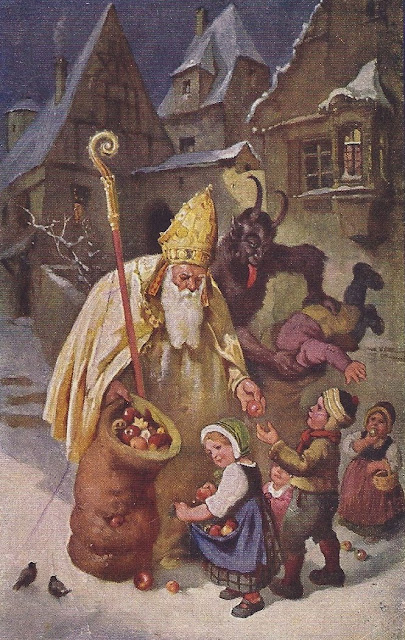Black Peter
Can the Devil be a bringer of good luck? Yes, indeed, according to old European traditions. The ancient devil -- known variously as Old Nick, Old Scratch, Old Split-Foot, and Der Teufel -- did not begin his career as the "Satan" of Christianity. The old Devil is a Teutonic woods-spirit, an ogre-like trickster who is often friendly to wood-cutters and footloose soldiers. In Germanic folk-tales like those collected by the Grimm brothers, he is usually described as living out in the woods, among the nature spirits.
In the area of Central and Eastern Europe comprising Germany, Austria, Hungary, and the Czech Republic, the Devil was never fully absorbed into the Christian mythos as Satan but remained as he had always been, a slender, horned, bearded, fur-covered half-man of the woods. Under the regional names Krampus, Schwarze Peter (Black Peter), and Knecht Ruprecht (Ruprecht the Servant), he accompanies Saint Nicholas on his rounds of gift-giving, originally on December 6th, but eventually on Christmas Day, December 25th.
Before elves and eight tiny reindeer, Santa had to contend with this much more menacing assistant, Black Peter (Zwarte Piet in Dutch). According to myths dating to the beginning of the 19th century, Saint Nicholas operated in the companionship of this indentured devil. Having triumphed over evil, it was said that on Saint Nicholas Eve, Black Peter was shackled and made to do St. Nick’s bidding. Traditionally St. Nicholas would hand out presents to good children, while it fell to Black Peter to dole out lumps of coal to children who misbehaved.
Black Peter's job was to remove the hay and carrots from the shoes that had been left by children underneath their chimneys, and to drop candy and gifts in their place. If the children had been bad, Peter wouldn't remove the hay and would leave a lump of coal in place of a gift. In parts of central Europe like Austria, Germany, and Switzerland, the character of Black Peter was more like a monster, with horns, long hair, and a red tongue. He was known by a variety of names: Klaubauf, Krampus, Grampus, Bartel.
The American version of St. Nicholas, or Santa Claus (AKA: Father Christmas, Old Saint Nick, etc.) originally came from the Dutch version called Sinterklaas. The Dutch settlers in New Amsterdam (New York) brought this fun and lively tradition (some even say cult) to America. Actually the old "cult" of Santa Claus incorporates many traditions: Christian and Pagan, Old Catholic, Scandinavian, Dutch, German and English. The relics of Saint Nicholas are in the basilica of St. Nicola, in Bari, Italy (they were stolen from Myra in 1087 AD). For this reason he is sometimes known as Saint Nicholas of Bari.
The American version of St. Nicholas, or Santa Claus (AKA: Father Christmas, Old Saint Nick, etc.) originally came from the Dutch version called Sinterklaas. The Dutch settlers in New Amsterdam (New York) brought this fun and lively tradition (some even say cult) to America. Actually the old "cult" of Santa Claus incorporates many traditions: Christian and Pagan, Old Catholic, Scandinavian, Dutch, German and English. The relics of Saint Nicholas are in the basilica of St. Nicola, in Bari, Italy (they were stolen from Myra in 1087 AD). For this reason he is sometimes known as Saint Nicholas of Bari.
Nowadays there is still not one universal image of Black Peter, but he has lost his large stick and is usually dressed in a Renaissance page style costume with short pants, stockings, and a cap with a large feather. Today, much of the negative associations have left Black Peter and he has become more of an elf-like figure, an assistant to an overloaded St. Nicholas who helps to hand out gifts every December 5th, St. Nicholas Day in Holland. But lurking beneath the thin veneer of modern tradition is Black Peter… Old Split Foot… an ancient will-o-the woods… dancing nude around the Yule-tide fire… amongst the nature spirits… carrying on the old ways… reveling in the pre-Christian, pagan rituals… chanting… Merry Christmas to all… and to all a good night!!!





Comments